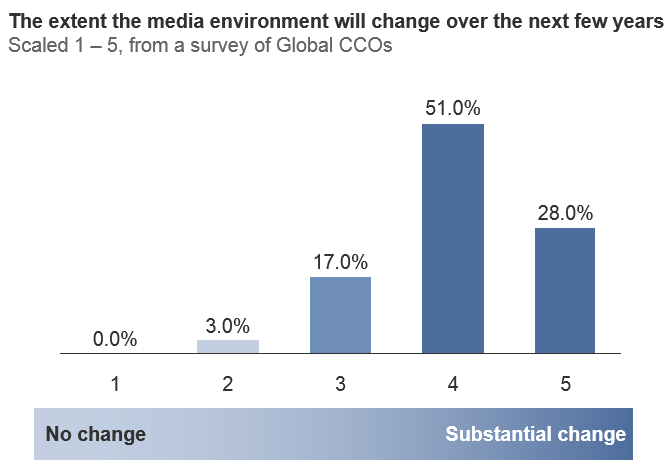The expanding role of the Chief Communications Officer

In today’s competitive landscape, business transformations must be closely linked with communication strategies in order to be effective. Korn Ferry, the world’s largest executive search firm, completed a survey that found Fortune 500 Chief Communications Officers (CCOs) have increasingly prominent roles and rising leadership expectations; in fact, 67% of respondents said that a strategic mindset was the most important leadership characteristic for successful CCOs.
CEOs expect CCOs to act as high-level strategic advisors, leading the charge on corporate positioning and ensuring that their companies’ messages are consistent across all touchpoints and audiences, including investors (and activist investors), customers and employees. What’s more, according to a study conducted by Weber Shandwick, 57% of CCOs reported to CEOs in 2014—a 14% increase from 2012—further boosting the strategic impact CCOs can have on business transformations.
With the ear of the CEO and rising expectations, corporate communications teams are increasingly relying on agencies to help with their strategic communications—which also means that, it is becoming more difficult to ensure that these corporate messages are consistent. So how can CCOs meet their new mandate?
Tech-enabled processes and tools cut through the noise—consistently
The study above further found that technological advancement was the leading factor for the changing environment that CCOs operate in today. In addition, 79% of CCOs anticipate that the media environment will change substantially over the next few years.
CCOs are rising to the complexity challenge and taking advantage of an arsenal of communication tools at their disposal, such as:
- Internal 360 feedback surveys to identify points of message misalignment and confusion
Your own employees are often the best source of information. By looking inward, corporate communications teams can zero in on the messages that are not resonating and clear up any confusion so that employees are properly aligned with the broader company messaging. Simple survey tools, such as Qualtrics or SurveyMonkey, can be used to drive meaningful insights. - Data-driven predictive measurement to pinpoint opportunities for communications improvement pre-release
Gone are the days of releasing a new messaging strategy or product launch without doing some form of testing first. Using predictive analytics, communications teams can quickly identify areas to optimize content before hitting publish in order to achieve maximum impact. Quantified Communications’ proprietary analytics platform can help you perfect messages specific for your audience and purpose. - Post-release customer surveys to recognize misalignment throughout the customer journey
Communications teams can learn what worked and what didn’t by reaching out to the people who matter most—their customers. Post-release customer surveys can surface additional areas for improvement at specific points in the customer journey that may have been overlooked prior to launch. Companies such as Medallia have advanced technology and processes to capture customer feedback across multiple channels to ensure you receive the best possible data.
As the influence of the CCO continues to grow, so do the expectations of the CEO and executive leadership team. Fortunately, there are better tools than ever before to assist with their initiatives.
To learn more about how we can help your team use analytics to inform and improve your corporate communications strategy, contact us at info@quantifiedcommunications.com.
